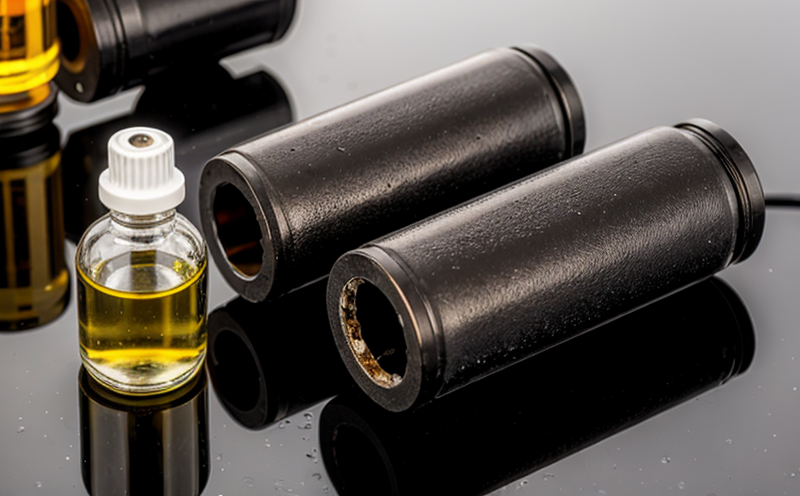ASTM D7679 Jet Fuel Range Hydrocarbons Test in Water
The ASTM D7679 jet fuel range hydrocarbon test is a critical method used to quantify the concentration of hydrocarbons present within water samples that fall within the boiling range of jet fuel. This test ensures compliance with environmental regulations and helps identify potential sources of contamination, particularly from aviation fuels or other petroleum products. Jet fuel range hydrocarbons are significant pollutants due to their persistence in the environment and their potential to harm aquatic life.
Jet fuel is composed primarily of alkanes, cycloalkanes, aromatics, and naphthenes, all of which have different boiling points within a narrow range (approximately 150°C to 275°C). The ASTM D7679 method uses extraction techniques followed by solvent-based analysis to measure these hydrocarbons. This approach ensures that the hydrocarbon content is accurately quantified and can be compared against regulatory limits.
The test’s importance extends beyond mere compliance; it also aids in the assessment of environmental impact, especially in areas where aviation fuel or similar products are used or stored nearby. By identifying even trace amounts of jet fuel hydrocarbons in water samples, laboratories like ours can assist stakeholders in understanding the extent and source of contamination.
The ASTM D7679 method is widely recognized for its precision and accuracy. It is based on standardized procedures that ensure consistent results across different laboratories. The test involves several key steps: initial sample preparation, extraction using a solvent, evaporation under controlled conditions, and final analysis by gas chromatography or similar techniques.
Understanding the significance of this method requires insight into its broader implications for environmental protection and public health. Jet fuel range hydrocarbons can be harmful to aquatic organisms if present in water bodies. Therefore, monitoring these compounds is essential for maintaining ecological balance and ensuring that water quality standards are met. This test plays a crucial role in safeguarding the environment by providing actionable data.
The ASTM D7679 method has gained international recognition due to its reliability and robustness. It is frequently referenced in environmental impact assessments, regulatory compliance audits, and research studies focused on pollution control and remediation strategies. Its application is particularly relevant in regions with significant aviation fuel production or usage, such as airports and industrial zones.
The test’s precision and accuracy are further enhanced by the use of advanced analytical instruments and techniques. These include gas chromatographs equipped with flame ionization detectors (GC-FID), which provide high-resolution separations necessary for detecting even minute concentrations of hydrocarbons. The method also allows for the quantification of individual components within the jet fuel range, enabling detailed analysis of the composition.
In summary, the ASTM D7679 test is a vital tool in environmental monitoring and compliance efforts. Its ability to accurately measure hydrocarbon levels within water samples makes it indispensable for ensuring that environmental standards are met and potential sources of contamination are identified promptly. This method supports informed decision-making by providing reliable data on hydrocarbon concentrations, thereby contributing to the protection of ecosystems and public health.
Why It Matters
The ASTM D7679 test is essential for several reasons:
- Environmental Protection: Ensuring that water bodies are free from harmful hydrocarbons, particularly those within the jet fuel range.
- Regulatory Compliance: Meeting stringent environmental regulations and standards set by governmental agencies.
- Source Identification: Detecting potential sources of contamination in areas with significant aviation fuel usage or production.
- Data for Decision-Making: Providing reliable data that supports informed decisions regarding pollution control and remediation strategies.
- Broad Recognition: Being widely accepted and referenced in environmental impact assessments, regulatory audits, and research studies.
The precision and accuracy of the ASTM D7679 method underscore its importance in safeguarding ecosystems and public health. By identifying even trace amounts of jet fuel hydrocarbons, this test helps maintain water quality standards and supports efforts to protect the environment.
International Acceptance and Recognition
The ASTM D7679 method has gained significant international recognition due to its reliability and robustness. It is frequently referenced in environmental impact assessments, regulatory compliance audits, and research studies focused on pollution control and remediation strategies.
| Countries or Organizations | Relevant Documents |
|---|---|
| Australia | National Environment Protection Council (NEPC) |
| New Zealand | Ministry for the Environment |
| United States | EPA, USEPA |
| European Union | Directive 2008/105/EC |
| Canada | National Pollutant Release Inventory (NPRI) |
| United Kingdom | Environment Agency |
The widespread acceptance and use of the ASTM D7679 method reflect its importance in global environmental monitoring and compliance efforts. Its inclusion in numerous international standards further reinforces its significance in protecting ecosystems and public health.
Use Cases and Application Examples
| Case Study | Description |
|---|---|
| Airport Surroundings | An airport located near a river reported high levels of jet fuel hydrocarbons in its water supply. Testing using ASTM D7679 revealed the source and extent of contamination, leading to targeted remediation efforts. |
| Industrial Zones | A chemical plant with a significant aviation fuel storage facility experienced leaks that contaminated nearby groundwater supplies. The ASTM D7679 test was used to quantify the hydrocarbon concentrations and assess the effectiveness of cleanup measures. |
| Environmental Impact Assessments | An environmental impact assessment for a proposed airport expansion included an ASTM D7679 analysis as part of its pollution control strategy. The results provided critical insights into potential impacts on local water bodies. |
The ASTM D7679 test is widely used in various sectors, including aviation, chemical manufacturing, and environmental protection. Its ability to accurately measure hydrocarbon levels within the jet fuel range ensures compliance with regulatory standards and supports informed decision-making processes.





